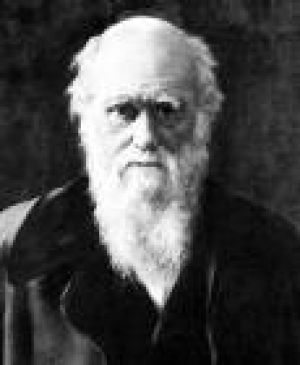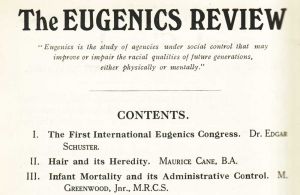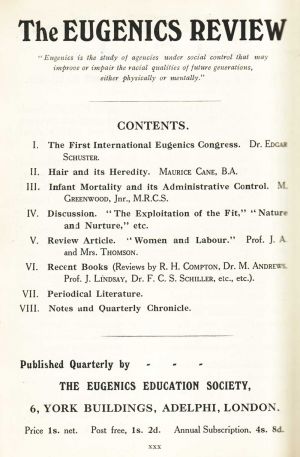General Question of the Care and Control of the Feeble Minded
( Delivered at a Meeting of the Finance and General Purposes Committee on the 1st Feb 1911)
He said –
This is one of the most urgent and most difficult of the many social problems confronting us today.
It is, however, satisfactory to find that most earnest efforts are being made to grapple with it, and to realize that the elimination of degenerate stock is the way to preserve a high standard of racial vigour.
Eugenics
The study of factors that influence the hereditary qualities of future generations. It may be thought of as both a science and a social movement. Eugenics proposes to improve humanity’s future by increasing the number of children produced by persons who are, by some definition, superior and by reducing the number produced by persons who are physically or mentally deficient. Attempts to encourage larger families from superior parents are called positive eugenics, attempts to reduce the number of children from defective parents negative eugenics.
The nineteenth century asylum was as much a prison as a house of cure. In the early years of that century there was hope of improvement but by its end, and especially afterDarwin’s Origin of Species had appeared, the prevailing opinion was that madness was hereditary and that the possessed should be removed from our midst and locked permanently up.
Initially doctors hunted for a cause, dissected brains, pulled out nerves, examined the blood, measured spinal columns, weighed glands, scraped, scratched and stumbled. Mental disease could be nothing more than an infection. Find it. Burn it down. Their patients languished. Their patients screamed. Their patients aged and greyed and failed. The rest of the world refused to look.
In 1858, two sentences captures the essence of the day. ‘Insanity is purely a disease of the brain. The physician is now the responsible guardian of the lunatic and must ever remain so.’
By the turn of the 20th century, psychiatry was still relatively new. The term ‘psychiatry’ emerged inBritainonly in 1858. Prior to that there were only ‘mad-doctors’ or ‘alienists’ and many of the large new asylums were run by ‘lay’ (i.e. non-medical) administrators.
In the Victorian period, fledgling psychiatry was faced with two challenges. One was to wrest political control of the asylum system from lay administrators. Another was to construct a credible knowledge base to underpin a form of medical authority over lunacy.
For over fifty years this position remained in the ascendancy in debates about lunacy. Indeed, the asylum system was taken over successfully by medical superintendents and contributed to the eugenic thought in Western intellectual culture.
However, this self-confidence was soon undermined by the ‘shellshock problem’ emerging after 1914. There was a fundamental incompatibility between a eugenic view about lunacy, the legacy from Victorian asylum doctors, and the grim reality of officers and gentleman and working class volunteers (‘England’s finest blood’) breaking down with predictable regularity in the trenches of the ‘Great War’.
To offer a eugenic explanation for the newly and, at first, confusingly, described neurotic reactions, witnessed in these traumatised soldiers, was tantamount to treason. Not only was the monopoly of this analysis now broken, but other modes of psychiatric thinking were made possible.
Neurosis, not just psychosis, now came within the ambit of psychiatry and psychoanalysis was finally offered some legitimacy after its pre-War dismissal by the leaders of psychiatry and neurology.
A year after the end of the War both the British Psychoanalytical Society and the Medical Section of the British Psychological Society were established. This moment could be read as the beginnings of a long heavyweight contest between biological psychiatrists and medical psychotherapists.
The poet Sassoon described this strange process in the following way:
“Shell-shock. How many a brief bombardment had its long-delayed after-effect in the minds of these survivors, many of whom had looked at their companions and laughed while the inferno did its best to destroy them. Not then was their evil hour, but now; now, in the sweating, suffocation of nightmare, in paralysis of limbs, in the stammering of dislocated speech. Worst of all, in the disintegration of those qualities through which they had been so gallant and selfless and uncomplaining – this, in the finer types of men, was the unspeakable tragedy of shell shock” (Siegfried Sassoon Sherston’s Progress)
Science Of Eugenics
From The Asylum News 1911
EUGENIC CONGRESS
The first International Eugenic Congress is to be held at the University of London, July 24th to 30th, 1912 under the Presidency of Major Leonard Darwin, and organized by the Eugenics Education Society.
As the congress is International, it is proper that the subjects submitted for consideration should be of wide importance and permanent interest. It is proposed to group the papers into the following four sections:-
The Bearing of Eugenics of Biological Research
Facts of Heredity ¡V Physiological aspects. Heredity. Variations, their nature and causation. Race Mixture.
The Bearing Upon Eugenics of Sociological And Historical Research.
Historical evidence with regard to changes in racial characters. Birth Rate and Death Rate Statistics. Effects of medical and surgical treatment in encouraging unfitness.
The Bearing Upon Eugenics of Legislaation And Social Customs.
Marriage Laws and Customs. Taxation. Economic Conditions. Insurance. Trades Unionism.
Consideration Of The Practical Applications of Eugenic Principles.
Prevention of the propogation of the unfit by segregation and sterilization. Voluntary restriction of the propogation of the unsound. The encouragement of the propogation of the fit. Promulgation of the Eugenic Ideal. The place of Eugenics in Educational Systems.
Thankfully we have moved on from this flawed understanding. Mental health problems can affect anyone at anytime. There is no immunity from it, nor should there be any stigma attached to it.
Winston Churchill
“Had he been a stable and equable man, he could never have inspired the nation. In 1940, when all the odds were againstBritain, a leader of sober judgment might well have concluded that we were finished,” wrote Anthony Storr about Churchill’s bipolar disorder in Churchill’s Black Dog, Kafka’s Mice, and Other Phenomena of the Human Mind.
Charles Dickens, Writer
One of the greatest authors in the English language suffered from clinical depression, as documented in The Key to Genius: Manic Depression and the Creative Life by D. Jablow Hershman and Julian Lieb, and Charles Dickens: His Tragedy and Triumph by Edgar Johnson
Ernest Hemingway, Writer
The Pulitzer Prize-winning novelist’s suicidal depression is examined in the True Gen: An Intimate Portrait of Ernest Hemingway by Those Who Knew Him by Denis Brian.
John Keats, Poet
The renowned poet’s mental illness is documented in The Dynamics of Creation by Anthony Storr and The Broken Brain: The biological Revolution in Psychiatry by Nancy Andreasen, M.D.
Abraham Lincoln, President of theUnited States
The revered sixteenth President of theUnited Statessuffered from severe and incapacitating depressions that occasionally led to thoughts of suicide, as documented in numerous biographies by Carl Sandburg.
Vivien Leigh, Actress
The Gone with the Wind star suffered from mental illness, as documented in Vivien Leigh: A Biography by Ann Edwards.
Michelangelo, Artist
The mental illness of one of the world’s greatest artistic geniuses is discussed in The Dynamics of Creation by Anthony Storr.
Isaac Newton, Scientist
The scientist’s mental illness is discussed in The Dynamics of Creation by Anthony Storr and The Key to Genius: Manic Depression and the Creative Life by D. Jablow Hershman and Julian Lieb







